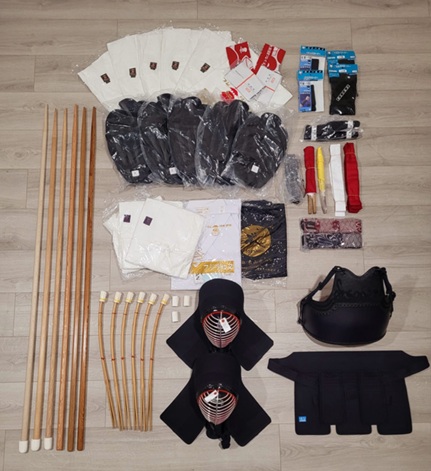by Hugo S. & Héloïse T.
In July 2025, the annual INF seminar was held in Matsuyama, Japan. Taking advantage of this opportunity to travel around the country, we also made the most of our trip by purchasing some Naginata equipment for ourselves and our friends. We are therefore offering you this article to share our experience with you.
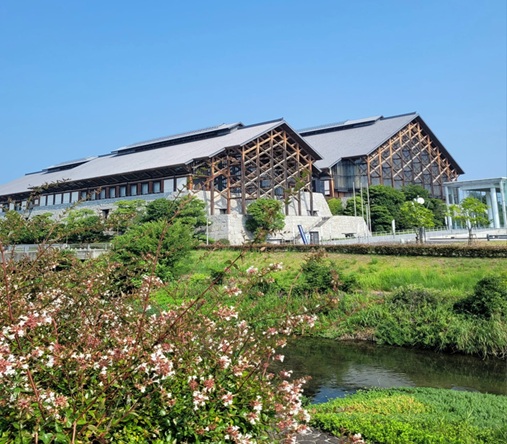
What to expect ?
During our trip, we visited various cities of all sizes and went to shops specialising in martial arts equipment and to artisans in each one.
Following these visits, we concluded that outside of very large cities (e.g. Tokyo), one should not expect to find Naginata equipment directly in shops. Indeed, the community practising Naginata (Tendo-ryu, Atarashii Naginata, etc.) remains limited in size even in Japan. Consequently, except for craftsmen, many shops have very little stock or only sell on order. Therefore, if you wish to purchase equipment during one of your stops, we advise you to stay there for at least a week or even a little longer so that you can place an order.
Furthermore, there are very few craftsmen left today who make the Naginata equipment they sell themselves. As a result, many place orders through a magazine shared by all resale shops, and the choice is therefore very limited by this intermediary.
Finally, do not expect to find everything you are looking for in a single shop. Once again, as stocks are limited and Western sizes can be rare for Japanese people, you will probably need to visit several shops.
How do I search for addresses ?
During our stay, we used several methods to find various shops.
The simplest way was to contact Japanese clubs directly or ask Japanese practitioners for the addresses they use to source their supplies. To contact them, we recommend using social media and writing to them in Japanese with the help of online translation tools. This will facilitate communication and make them more inclined to answer your questions.
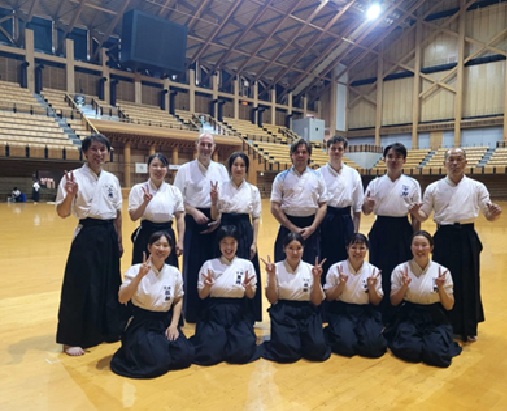
Next, the other method we used was to search directly on Google using the following kanji characters: 武道具店.
However, be careful with this method. These kanji characters refer very broadly to martial arts equipment shops. They will therefore direct you to retailers specialising in Kendo, Aikido, Karate or any other martial art. Furthermore, as Google is not the most reliable software when it comes to Japan, we found many addresses that were no longer open when we visited them.
How should one address sellers ?
Given that Japanese people place particular importance on politeness and based on the experiences of some of our friends in certain shops, we feel it is necessary to make a point about how to address and communicate with shop assistants.
We advise you to use polite phrases as much as possible in your requests (please, thank you, etc.) and not to hesitate to apologise politely when a request seems unusual or difficult for the salesperson to fulfil.
Furthermore, even if you have difficulty expressing yourself in Japanese, the least you can do is greet people and introduce yourself in Japanese so that you can explain the reasons for your visit directly to the person you are talking to. In fact, in all the shops we visited, when we did not say anything ourselves, the sales assistants sought to find out who we were, where we came from and what we were looking for in order to cultivate their business relationship with us.
Although these elements may not seem straightforward at first glance, they are necessary because they will enable you to establish a relationship of exchange with your interlocutor and avoid any abruptness that could put them off. Furthermore, once the relationship has been established, they will enable you to make more specific and demanding requests. For example, we were able to get a craftsman to repair some of our equipment free of charge and learn some of his methods for repairing equipment.
The Japanese are excellent salespeople once the language barrier is broken down in favour of mutual trust and passion for martial arts.
A few tips
As mentioned above, Naginata remains a relatively uncommon art in Japan compared to others such as Judo and Aikido. As a result, retailers are sometimes unaware of the expected characteristics of the equipment. We therefore advise you to always ask to inspect, weigh and test the various products and ask your salesperson a few questions when making your purchase. This will allow you to check its condition.
In addition, to ensure your requests are understood, do not hesitate to use online translators or photographs. This will enable them to better understand your request and improve its processing by avoiding misunderstandings.
Finally, when travelling by plane with naginatas, we advise you to inform the baggage handlers what they are and reassure them that they are just ‘wooden sticks’. This will prevent you from causing panic among staff and long delays with the police…
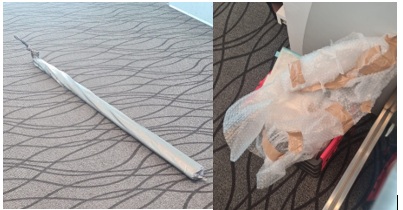
Which companies should you use ?
Having considered which airlines to use for travelling ourselves, we would like to share our opinion on the one we used and another one we discussed with our Canadian friends.
As for us, we flew with Japan Airlines. This airline allowed us to bring two pieces of luggage weighing 23 kg each per person, with a maximum linear volume of 203 cm. This allowed us to transport all our equipment and purchases in three suitcases and our naginatas in a fourth package. Furthermore, regarding weight distribution, the weight is calculated based on the total weight and not the individual distribution in each suitcase. Therefore, although our naginatas weighed a total of 4 kg, we were able to take 92 kg of luggage with us by distributing the remaining 88 kg among our three other suitcases.
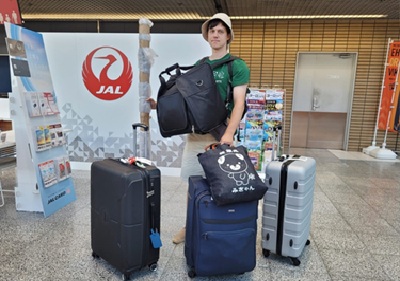
Finally, our Canadian friends we met during the seminar shared their experience with us, explaining that with the American airline Delta, equipment can be transported free of charge if you specify that it is sports equipment. In addition, they seemed to say that this solution allowed them to travel more economically than with airlines such as Japan Airlines.
We hope this article will be useful for your future trips to Japan.


